Yellampalli S. (ed.) Carbon Nanotubes - Synthesis, Characterization, Applications
Подождите немного. Документ загружается.


Microwave Absorption Characteristics of Carbon Nanotubes
277
[11] Haiyan Lin, Hong Zhu , Hongfan Guo, Liufang Yu. Investigation of the microwave-
absorbing properties of Fe-filled carbon nanotubes. Materials Letters 61 (2007)
3547–3550.
[12] Renchao Che, Lian-Mao Peng,Xiao Feng Duan, et al. microwave
absorption enhancement and conplex permitivity and permeability of
Fe encapsulated within carbon nanotubes. Adv.Mater2004,16,
No.5:401-404.
[13] Yong Li , Changxin Chen , XiaoyanPan , Yuwei Ni, Song Zhang , Jie Huang ,
Da Chen , Yafei Zhang. Multiband microwave absorption films based on
defective multiwalled carbon nanotubes added carbony liron/acrylicresin.
PhysicaB,(2009):1-4.
[14] Hongtao Zhao, Xijiang Hana, Miaofei Han, Lifang Zhang, Ping Xu. Preparation and
electromagnetic properties of multiwalled carbon nanotubes/Ni composites
by γ-irradiation technique. Materials Science and Engineering B 167 (2010)
1–5.
[15]YingqingZhan,RuiZhao,YajieLei,FanbinMeng,JiachunZhong,Xiaobo Liu. A
novelcarbonnanotubes/Fe3O4
inorganichybridmaterial:Synthesis,Characterizationandmicrowaveelectromagnetic
properties. .Magn.Magn.Mater.(2010):1-5.
[16] Chen Wang, Ruitao Lu, Feiyu Kang, Jialin Gu, Xuchun Gui, DehaiWu. Synthesis
and application of iron-filled carbonnanotubes coated with FeCo
alloynanoparticles. Journal ofMagnetismand Magnetic Materials 321 (2009)
1924–1927.
[17] Peng Zhihua, Peng Jingcui, Peng Yanfeng, Ou Yangyu, Ning Yantao. Complex
permittivity and microwave absorption properties of carbon
nanotubes/polymer composite: A numerical study. Physics Letters A 372 (2008)
3714–3718.
[18] Po Chul Kim, Dai Gil Lee. Composite sandwich constructions for absorbing the
electromagnetic waves. Composite Structures 87 (2009) 161–167.
[19] Lan Zhang a, Hong Zhu. Dielectric, magnetic, and microwave absorbing properties of
multi-walled carbon nanotubes filled with Sm2O3 nanoparticles. Materials Letters
63 (2009) 272–274.
[20] Igor Maria De Rosa, Adrian Dinescu , Fabrizio Sarasini, Maria Sabrina
Sarto, Alessio Tamburrano. Effect of short carbon fibers and MWCNTs
on microwave absorbing properties of polyester composites containing
nickel-coated carbon fibers. Composites Science and Technology 70 (2010) 102–
109.
[21] Zhuangjun Fan, Guohua Luo, Zengfu Zhang, Li Zhou, Fei Wei. Electromagnetic and
microwave absorbing properties of multi-walled carbon nanotubes/polymer
composites. Materials Science and Engineering B 132 (2006) 85–89.
[22] Xiaoshu Zeng ,Xiaogang Sun, Guoan Cheng, Xiaosong Yan,Xianliang Xu.
Production of multi-wall carbon nanotubes on a large scale. Physica B 323
(2002) 330–332.

Carbon Nanotubes - Synthesis, Characterization, Applications
278
[23] C.X. Hu, Z.H. Wang, W.Z. Li, Stealth coating technology, first ed., Chemical Industrial
Publishing, Bei Jing, 2004.
14
Structural Instability of Carbon Nanotube
I-Ling Chang
National Cheng Kung University
Taiwan
1. Introduction
Since Iijima reported MWCNTs in 1991, CNTs have captured the intensive attention of
researchers worldwide due to the combination of their expected structural perfection, small
size, low density, high stiffness, high strength, and excellent electronic properties. CNTs
have been widely adopted as microscopic probing tips (Dai et al., 1996; Hafner et al., 2001),
nanocomposites reinforcements (Bower et al., 1998; Jin et al., 1998), nanotweezers (Kim &
Lieber, 1999), and nanoactuators
(Baughman et al., 1999; Fennimore et al., 2003) due to their
slender and high aspect ratio structures. Meanwhile, nanotubes are also highly susceptible
to buckling under compression, which is a structural instability. Once the buckling of CNTs
occurs, the load-carrying capability would suddenly reduce and lead to possible
catastrophic failure of the nanotubes, which significantly limit the loading strengths of the
probing tips and compressive strengths of nanocomposite structures. Even the physical
properties such as conductance of carbon nanotube can be influenced by the occurrence of
buckling (Postma et al., 2001). Hence, it is crucial to understand the mechanism of nanotube
buckling and even predict the onset of buckling in order to improve the nanotube
applications.
A review of the relevant literature shows that significant studies have employed both
experimental (Falvo et al., 1997; Iijima et al., 1996; Thostenson & Chou, 2004; Waters et al.,
2004) and theoretical (Ru, 2000; Yakobson & Avouris, 2001) approaches to investigate the
bucking behaviors of CNTs.
However due to the difficulties encountered at nanoscale, the
experimental investigation of the buckling behaviors of CNTs remains a challenging
problem and individual factors that affect buckling could not be easily identified. In
theoretical study, the CNTs are commonly treated as beams or thin-shell tubes with certain
wall thickness and elastic constants and, thus, it is difficult to consider the chirality and size
effects on buckling behavior of CNTs because the continuum assumption disregards the
discrete nature of atomic structures (Ru, 2000; Yakobson & Avouris, 2001). Some researchers
attempted to introduce the atomic-continuum method combining the atomic detail in the
continuum description and examine the various properties of CNTs (Chang, 2004; Guo et
al., 2008; Li & Chou, 2003a, 2003b). The atomic-continuum method could shorten the
computational time in larger atomic system.
As the fast development and rapid advancement of computers, molecular approaches have
become important tools and are widely applied to study the factors that would influence the
buckling of CNTs (Buehler et al., 2004; Cao & Chen, 2006a, 2006b; Huh & Huh, 2008; Liew et
al., 2004; Ozaki et al., 2000). Although some researchers already discussed various aspects of
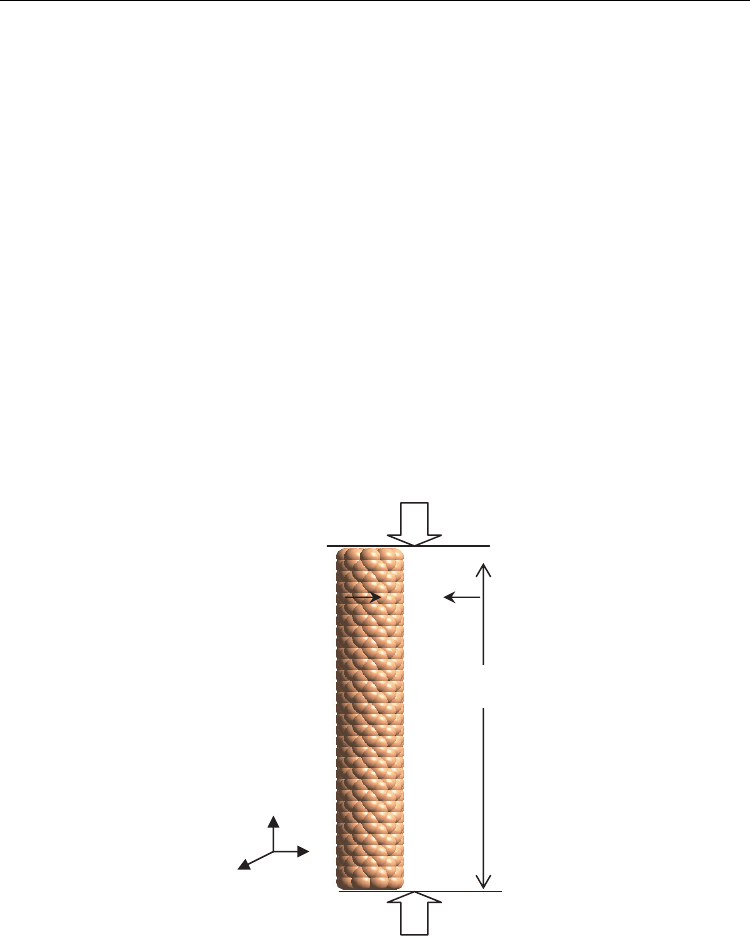
Carbon Nanotubes - Synthesis, Characterization, Applications
280
the CNT buckling behavior, systematic analysis on the effect of geometry (i.e. radius, length
and length-to-radius ratio) and chirality (i.e. armchair, zigzag and chiral) on the buckling
mechanism is still lacking to the best of our knowledge. Consequently, the present study
employs MD simulations based on the Tersoff many-body potential function (Tersoff, 1986,
1988, 1989) to perform a systematic and comprehensive investigation into the buckling
behaviors of single-walled CNTs under uniaxial compressive displacement loading. Besides,
the applicability of the continuum buckling theory, which has been well developed for thin
tubes, on predicting the buckling behavior of the CNT will also be examined.
2. Methodology
Atomic model of the single-walled CNT with radius r and axial length L are illustrated in
Fig. 1. All simulations are performed at room temperatures, 300K using a rescaling method
and Newton’s equations of motion are solved using a fifth order Gear’s predictor-corrector
algorithm. The empirical Tersoff many-body potential (Tersoff, 1986, 1988, 1989), which is
commonly adopted in CNTs molecular simulation studies to provide quick estimation and
significant insight into the thermo-mechanical behavior, is employed to describe the
interatomic interaction between the carbon atoms. The force acting on an individual atom is
obtained by summing the forces contributed by the surrounding atoms. The initial atomic
models of CNT will be relaxed under NTP ensemble for 10000 time steps with a 1 fs step size
to make sure the nanotubes reach their equilibrium states.
Fig. 1. The schematic presentation of the CNT under uniaxial compression.
During the simulations, the nanotube is compressed uniaxially and incrementally along z
direction by a uniform strain under NTV ensemble. The periodic boundary condition (PBC)
is applied in the axial direction, which served as a loading mechanism to apply uniform
displacements. Minimum image criterion is adopted to implement the periodic boundary
L
2r
x
y
z
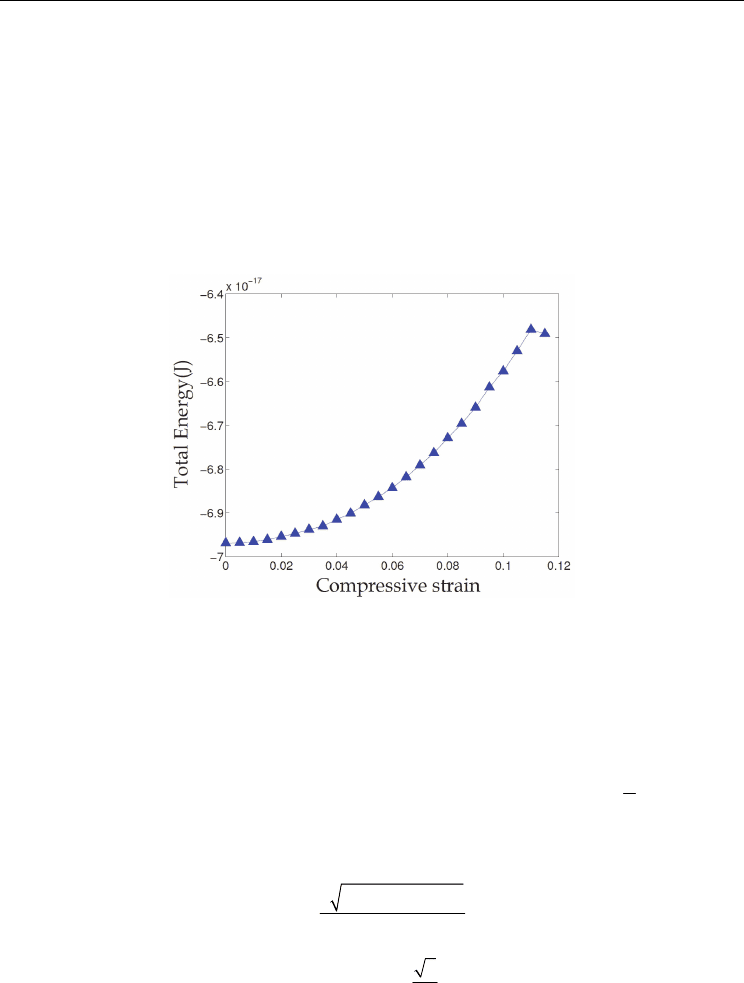
Structural Instability of Carbon Nanotube
281
condition. In order to reduce the loading strain rate, additional MD steps are applied for the
relaxation of the CNT after each stage of the compression. The equilibrated configuration
will be used as the initial state for the next loading step. In this study, the applied strain
increment is 0.5%, then the CNT atomic system is relaxed for the interval of 10 ps and the
corresponding strain rate is 0.05% ps
-1
. The total energy, pressure and atomic configuration
of the relaxed structure are monitored at each loading step to determine whether the
buckling of the CNT occurs. Once a sudden jump in the total energy, as illustrated in Fig. 2,
is observed, the atomic configuration of the nanotube would be inspected. Buckling strains
(or called critical compressive strains) can be indicated from the jumps in the total energy
and pressure.
Fig. 2. The relation between the system energies and compressive strains for (5,5) CNT with
length of 7.38Å.
CNTs can be considered as a graphene sheet rolled into a cylindrical shell and three distinct
types of nanotubes could be classified as armchair, zigzag and chiral according to the way of
rolling-up. In order to assess the influence of geometry and chirality on the buckling
behavior of the single-walled CNTs, various radii, lengths, length-to-radius ratios and
helical types of CNTs would be simulated and elucidate the dependence of buckling strain.
The length-to-radius ratio (or called slenderness ratio) is defined as
..
L
SR
r
=
. The radius
and translation length, which is the smallest periodic axial distance, of (m,n) CNTs can be
calculated as
22
3( )
2
anmmn
r
π
++
=
(,)
3
2
mn
R
Tr
d
π
=
where a is the interatomic C–C bond length, 1.42Å and
R
d is the greatest common divisor of
2n + m and 2m + n. Since the periodic boundary condition is employed as a loading

Carbon Nanotubes - Synthesis, Characterization, Applications
282
mechanism, the simulated CNT length must be multiple of the translation length so that the
complete six-membered ring structure of the CNT could be preserved. The geometric
parameters, radius r and length L, for different chiralities of CNTs are listed in Table 1-3,
respectively. Similar radius, length and slenderness ratio for armchair, zigzag and chiral
CNTs are chosen, if possible, for the simulation. Since the translation lengths for (6,4), (9.6)
and (12,8) chiral CNTs are 18.569 Å, the choices of slenderness ratios for chiral CNTs are
more limited.
(m,n) (5,5) (8,8) (10,10)
Radius(Å) 3.39 5.424 6.78
Length(Å) / S.R. 7.38 / 2.18
12.30 / 3.63
36.89 / 10.88
61.49 / 18.14
86.08 / 25.39
147.57 / 43.53
12.3 / 2.27
19.68 / 3.63
59.03 / 10.88
98.38 / 18.14
137.73 / 25.39
236.11 / 43.53
14.76 / 2.18
24.595 / 3.63
73.79 / 10.88
122.98 / 18.14
172.165 / 25.39
295.14 / 43.53
Table 1. The radii and lengths of the modeled armchair CNTs
(m,n) (9,0) (14,0) (17,0)
Radius(Å) 3.523 5.48 6.655
Length(Å) / S.R. 8.52 / 2.42
12.78 / 3.63
38.34 / 10.88
63.9 / 18.14
89.46 / 25.39
153.36 / 43.53
12.78 / 2.33
21.3 / 3.89
59.64 / 10.88
97.98 / 17.88
140.58 / 25.65
238.56 / 43.53
17.04 / 2.56
25.56 / 3.84
72.42 / 10.88
119.28 / 17.92
170.4 / 25.60
289.68 / 43.53
Table 2. The radii and lengths of the modeled zigzag CNTs
(m,n) (6,4) (9,6) (12,8)
Radius(Å) 3.413 5.119 6.825
Length(Å) / S.R. 18.569 / 5.44
37.138 / 10.88
55.707 / 16.32
92.845 / 27.20
148.55 / 43.52
18.569 / 3.62
55.707 / 10.88
92.845 / 18.14
129.982 / 25.39
222.83 / 43.53
18.569 / 2.72
74.276 / 10.88
129.982 / 18.92
167.712 / 24.57
297.10 / 43.53
Table 3. The radii and lengths of the modeled chiral CNTs
3. Results
MD approaches are utilized to simulate the uniaxial compression test of CNTs with different
geometries and chiralities. The size and chirality effects on buckling behaviors are studied
and systematically compared through the critical compressive strains. It is noticed that two
distinct types of buckling configurations are commonly observed as shown in Fig. 3 (a) and
(b). One is shell wall buckling with kinks on the wall with the tube’s centerline remaining
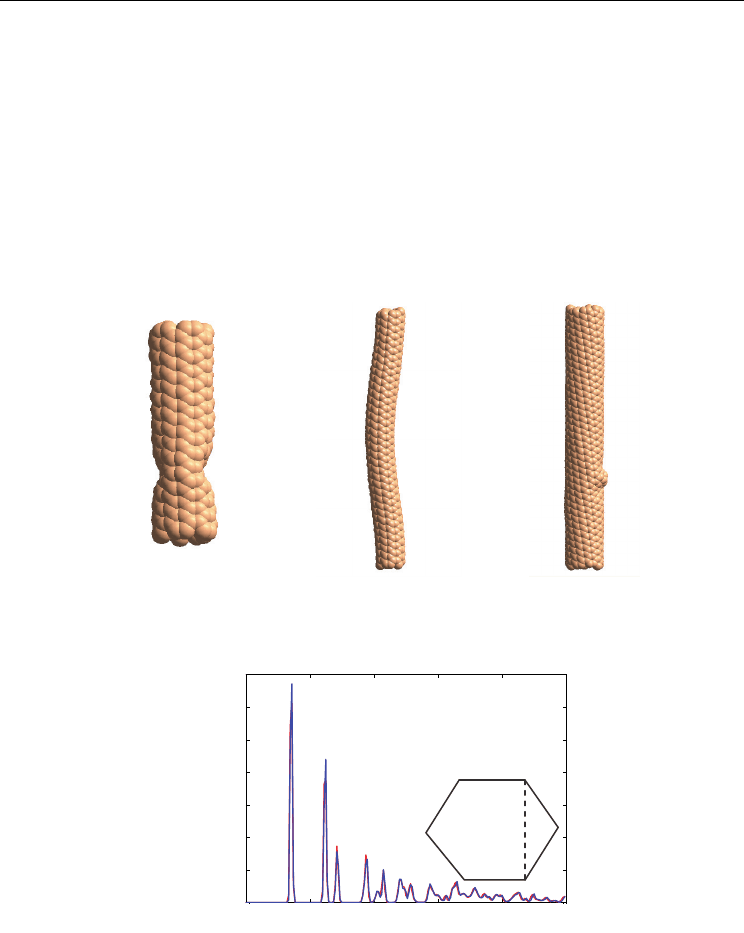
Structural Instability of Carbon Nanotube
283
straight, which is a local instability and the other is column buckling, which buckle as a
whole. Moreover, there is another intriguing type of initial buckling configuration, which
starts with a bump on the wall as shown in Fig. 3(c), and the CNT will eventually turn into
column or shell wall buckling. It is also observed that the buckling kinks or bends appear
mostly near the middle of the nanotubes, which indicates the loading mechanism does not
impose any extra constraint on the two ends. Unlike the velocity controlled loading (Jeng et
al, 2004), the drastic deformation starts from the imminent places near the ends due to
Poisson’s effect. Hence, it is difficult to separate the boundary constraint effect from the
other investigating factors. It is also noted that the radial distribution function before and
after buckling is quite similar as shown in Fig. 4, which implies that the bond structures do
not change due to buckling.
(a) (b) (c)
Fig. 3. The buckled shapes of CNTs. (a) shell wall, (b) column and (c) bump on the wall.
Fig. 4. The radial distribution functions before and after buckling.
The buckling strains for different chirality and slenderness ratio of CNTs are shown in Fig.
5, 6 and 7, respectively. The filled marks indicate column buckling and the empty one
indicate shell wall buckling. In general, the nanotube’s buckling behavior transits from shell
0 2 4 6 8 10
0
500
1000
1500
2000
2500
3000
3500
1.42
Å
2.46
Å
2.84
Å
- before buckling
- after buckling
1.42
Å
2.46Å
Distance between atoms (
Å
)
Radial distribution function
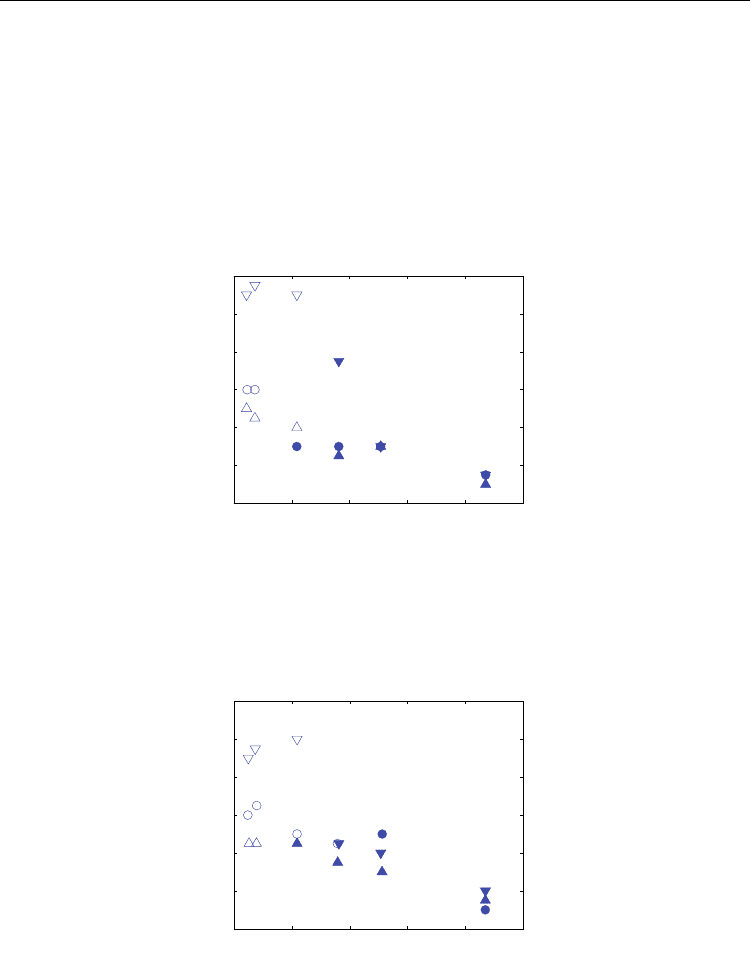
Carbon Nanotubes - Synthesis, Characterization, Applications
284
wall type for a short tube to column type for a long tube of the same radius irrespective to
the chirality of the CNTs. For slender nanotubes ( . . 20SR ≥ ), axial compression results in
“global buckling” while the nanotubes undergo “local buckling” for stout nanotubes
(.. 10SR ≤ ). It is noticed that the slenderness ratio has strong influence on the buckling
strains and the buckling strains decrease rapidly with the increase of slenderness ratio
particularly for CNTs with smaller radii. Under similar length-to-radius ratio, it is noted that
the buckling strain decreases as the radius of the CNT increases especially for CNTs with
smaller slenderness ratios. It is observed that the chirality of the CNTs does not affect the
buckling behaviors and buckling strains significantly.
0 10 20 30 40 50
0
2
4
6
8
10
12
Fig. 5. The relationship between the buckling strain and slenderness ratio for armchair
CNTs. ▽▼: (5,5), ○●: (8,8), △▲: (10,10) CNT.
0 10 20 30 40 50
0
2
4
6
8
10
12
Fig. 6. The relationship between the buckling strain and slenderness ratio for zigzag CNTs.
▽▼: (9,0), ○●: (14,0), △▲: (17,0) CNT.
S.R.
Buckling strain(%)
S.R.
Buckling strain(%)
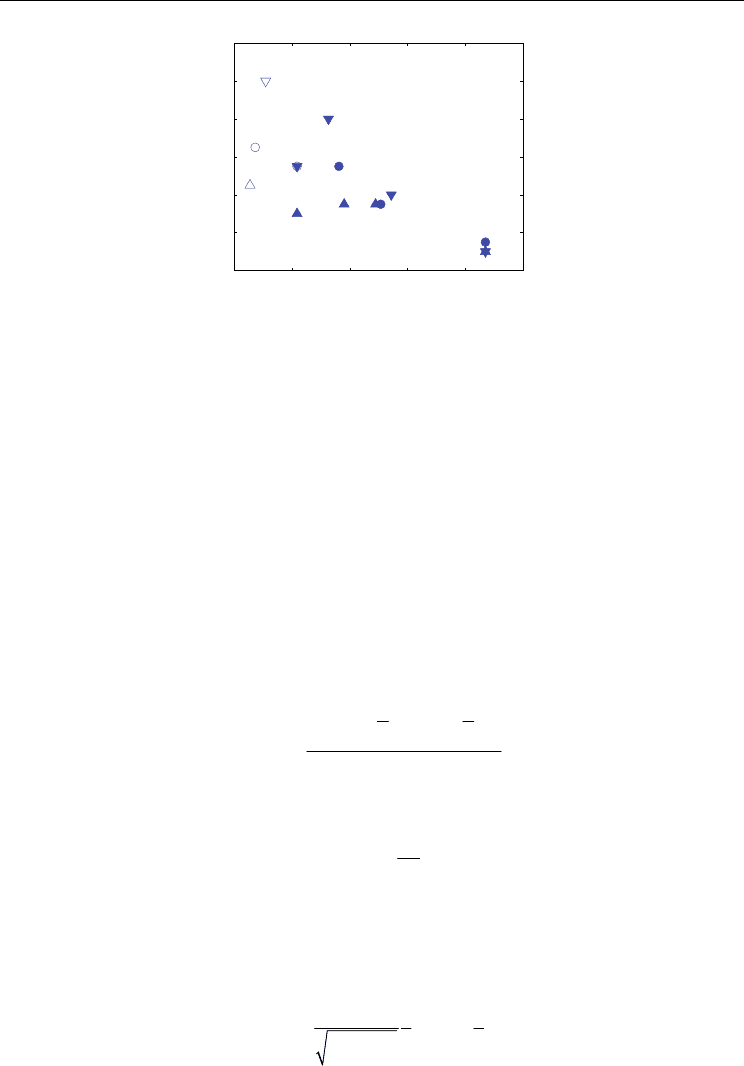
Structural Instability of Carbon Nanotube
285
0 10 20 30 40 50
0
2
4
6
8
10
12
Fig. 7. The relationship between the buckling strain and slenderness ratio for chiral CNTs.
▽▼: (6,4), ○●: (9,6), △▲: (12,8) CNT.
4. Analysis and discussion
From current simulation results, it is very difficult to deduce a clear relationship between
the critical compressive buckling strain and the CNT geometry and helical type, not to
mention predicting the buckling type. In continuum mechanics, there already exist theories
to calculate the buckling strain of thin shell tube depending on the buckling type in
macroscopic scale. However, the applicability of continuum buckling theory in nanoscale is
still an unsolved question. Hence, the continuum predictions on the buckling strains and the
simulation results will be compared in order to examine the applicability.
By using Euler-Bernoulli beam theory, the critical buckling strain of a tube with both ends
clamped displaying the column-like buckling behavior can be described as (Landau et al.,
1986)
22
2
2
22
column
cr
tt
rr
L
π
ε
+−−
=
. (1)
where t is the thickness of the tube. If
tr<< , the equation could be rewritten as
2
2
column
cr
r
L
π
ε
=
(2)
It is noticed that the critical compressive buckling strain decreases as the inverse square of
the slenderness ratio for column-type buckling. On the other hand, the critical compressive
buckling strain of the tube displaying the shell-like buckling behavior is
(Libai & Simmonds,
1998; Timoshenko & Gere, 1961)
()
2
1
0.588
31
shell
cr
tt
rr
ε
ν
=≈
−
(3)
S.R.
Buckling strain(%)
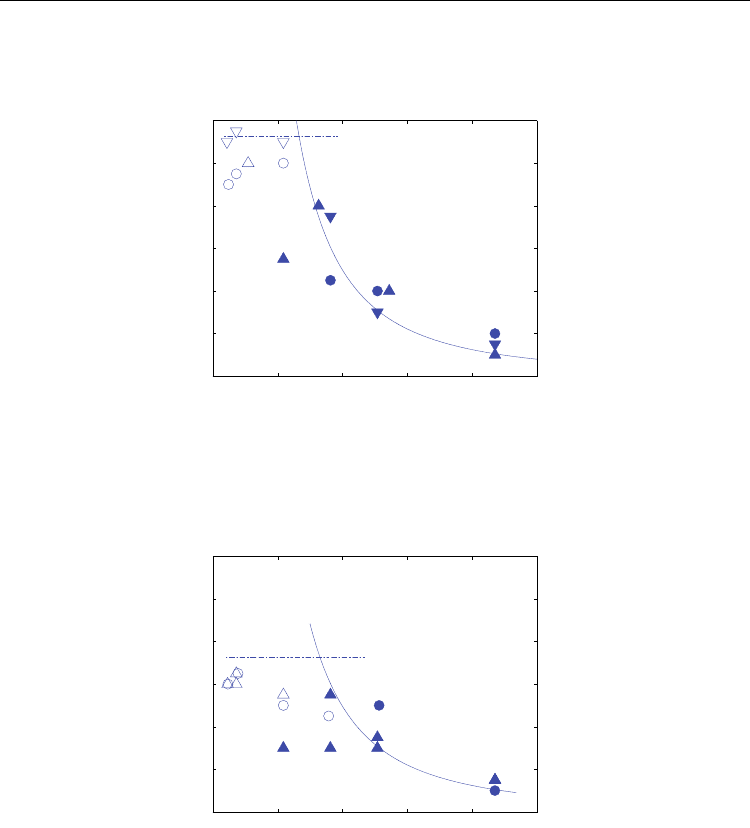
Carbon Nanotubes - Synthesis, Characterization, Applications
286
The Poisson’s ratio, ν, of the CNTs is chosen as 0.19 (Yakobson et al. 1996). It is noted that
the critical compressive strain of shell-like buckling depends only on the tube thickness and
radius, but is independent of the tube length.
0 10 20 30 40 50
0
2
4
6
8
10
12
Fig. 8. The comparisons between the continuum predictions and molecular simulation
results for CNTs.
▽▼:(5,5), ○●:(9,0) and △▲:(6,4)
0 10 20 30 40 50
0
2
4
6
8
10
12
Fig. 9. The comparisons between the continuum predictions and molecular simulation
results for CNTs.
▽▼:(8,8), ○●:(14,0) and △▲:(9,6)
Fig. 8, 9 and 10 illustrate the comparisons between the continuum predictions on the
buckling strains and the simulation results for respective set of similar radii. One of the
uncertainties of the continuum model is the effective nanotube thickness. Here in this
research, the effective nanotube thickness is chosen as 0.66Å (Yakobson et al. 1996), which is
roughly the atomic radius of carbon, instead of the commonly used CNT wall thickness, 3.4
Å. Since the nanotube thickness is not negligible as compared to the radius, Eq. (1) is
S.R.
Buckling strain(%)
S.R.
Buckling strain(%)
